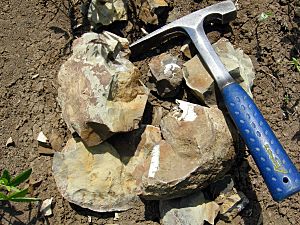Pierre Shale facts for kids
Quick facts for kids Pierre ShaleStratigraphic range: Campanian |
|
|---|---|

|
|
| Type | Geological formation |
| Underlies | Fox Hills Formation |
| Overlies | Niobrara Formation |
| Lithology | |
| Primary | Shale |
| Location | |
| Coordinates | 44°23′42″N 100°24′43″W / 44.395°N 100.412°W |
| Region | North America |
| Country | |
| Type section | |
| Named for | Fort Pierre |
| Named by | Meek & Hayden, 1862 |
The Pierre Shale is a special type of rock layer found in North America. It formed during the Upper Cretaceous period, which was a very long time ago, about 80 to 70 million years ago! You can find this rock formation east of the Rocky Mountains in the Great Plains, stretching all the way from Canada down to New Mexico.
This rock layer is mostly made of dark-gray shale. It also contains shiny gypsum veins and round, hard rocks called concretions that often hold amazing fossils. The Pierre Shale is important because it tells us a lot about what the Earth was like millions of years ago.
Contents
What is the Pierre Shale?
The Pierre Shale was first described in 1862 by two scientists, Meek and Hayden. They noticed it was a dark-gray rock with fossils and other minerals. They named it after a place near Fort Pierre, South Dakota, on the Missouri River.
At its thickest point, the Pierre Shale can be about 700 feet (210 meters) deep! It sits on top of another rock layer called the Niobrara Formation and is covered by the Fox Hills beds.
An Ancient Ocean Home
The Pierre Shale formed in an ancient ocean called the Western Interior Seaway. This was a huge, shallow sea that once covered much of central North America. Imagine a time when dinosaurs roamed the land, and a vast sea stretched across what is now the middle of the continent!
The mud and tiny bits of rock that settled at the bottom of this sea eventually turned into the shale we see today. The Pierre Shale is similar to other rock layers found further west, like the Bearpaw Shale and Mancos Shale, all formed in the same ancient ocean.
Most of the Pierre Shale formed during a time called the Campanian Age. However, some parts of it, especially in Raton, New Mexico, continued to form into the early Maastrichtian Age. These are both parts of the Upper Cretaceous period.
Resources from the Pierre Shale
Even though it's an ancient rock, the Pierre Shale is still important today. It holds valuable natural resources like oil and natural gas. For example, oil has been found in this formation in places like Fremont County, Colorado, and the Boulder Oil Field. More recently, natural gas has been taken from the Pierre Shale in the Raton Basin in southern Colorado.
Usually, shale is too dense for oil and gas to flow easily. But in some areas, the rock has natural cracks, or engineers create cracks using a process called hydraulic fracturing. This allows the oil and gas to be extracted.
Ancient Life in the Pierre Shale
The Pierre Shale is famous for the amazing fossils it contains. These fossils give us clues about the creatures that lived in the Western Interior Seaway millions of years ago. You can find fossils of ancient birds, marine reptiles, sharks, and many types of invertebrates.
Ancient Birds
Scientists have found fossils of ancient diving birds called Hesperornithiformes in the Pierre Shale. These birds were like giant, flightless loons or grebes. They had strong legs for swimming and hunting fish in the ancient sea.
| Ancient Birds from the Pierre Shale | |||
|---|---|---|---|
| Genus | Species | Location Found | Rock Layer (Member) |
|
Brodavis |
B. varneri |
South Dakota |
Sharon Springs member |
|
B. sp. |
Manitoba |
Pembina member |
|
|
H. bairdi |
South Dakota |
Sharon Springs member |
|
|
H. chowi |
Manitoba & South Dakota |
Pembina, Millwood, & Sharon Springs members |
|
|
H. lumgairi |
Manitoba |
Pembina member |
|
|
H. macdonaldi |
Manitoba & South Dakota |
Gammon, Pembina, Millwood(?), & Sharon Springs members |
|
|
H. mengeli |
Manitoba & South Dakota |
Pembina & Sharon Springs members |
|
|
H. regalis |
Manitoba, South Dakota, & Kansas |
Gammon, Pembina, & Sharon Springs members |
|
Marine Reptiles and Fish
The sea that formed the Pierre Shale was home to many large and fearsome marine animals. Here are some of the incredible creatures whose fossils have been discovered:
- Squalicorax (a type of shark)
- Gillicus (a large bony fish)
- Platecarpus (a type of mosasaur, a marine lizard)
- Styxosaurus (a long-necked plesiosaur)
- Plioplatecarpus (another mosasaur)
- Cretolamna (a shark)
- Pseudocorax (a shark)
- Enchodus (a fish with long fangs)
- Carcharias (a shark)
- Archelon (a giant sea turtle)
- Dolichorhynchops (a short-necked plesiosaur)
- Prognathodon (a powerful mosasaur)
- Xiphactinus (a huge, predatory fish)
- Clidastes (a smaller mosasaur)
- Tylosaurus (a very large mosasaur)
Invertebrates
Besides big animals, the Pierre Shale also holds fossils of smaller creatures without backbones, called invertebrates.
- Inoceramus (a giant clam-like mollusk)
- Many types of ammonites (shelled creatures related to modern squids and octopuses)
- Several species of Baculites (a straight-shelled ammonite)


